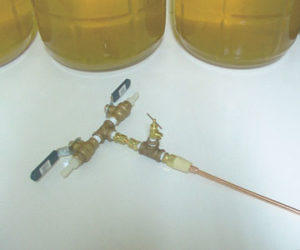Better Bottling: Techniques

According to some Eastern philosophies, every good thing has a corresponding bad thing. Every ying has its yang. For homebrewers, we have our beer (good) and our bottling (bad). Luckily, with a little planning and the proper equipment, we can minimize the drudgery of bottling.
First, it’s important to know that there are alternatives to bottling. Kegging is quick and easy, but it also requires a large initial investment (usually $150 to $200) and a large amount of fridge space. And even if you do keg, there are times you’ll want some bottled beer. Bottled beer is easy to give away and carry to parties. Plus, entries for homebrew contests need to be packaged in bottles.
The basic idea in bottling is to move your beer from one big container (your fermenter) to numerous small containers (the bottles). In the process, you want to avoid introducing any oxygen, bacteria or wild yeasts to the beer. Oxygen introduced after fermentation will cause the beer to go stale faster. Bacteria or wild yeasts can lead to off flavors in the beer or gushing bottles. For bottle-conditioned beers, you also want to prepare the beer so it will carbonate to the right level in the bottle. There are four steps to bottling: cleaning, sanitizing, preparing the beer and filling the bottles.
The equipment you’ll need: a bottling bucket, a racking cane, a large spoon, tubing to move the beer from the bucket, a tubing clamp or a bottle filler, bottles, sugar, bottle caps and a capper. A large picnic cooler is a convenient container to sanitize your bottles in.
—————————————————————–
Bottle Selection
Bottle Type Number of Bottles
5 gallon Cornelius keg 1
2 L “growler” 10
1 L “torpedo” 20
22 oz. bottle 29
16 oz. bottle 40
12 oz. bottle 53
6 oz. bottle 107
—————————————————————-
You can modify how much work bottling is by selecting bottles of different sizes. The chart on this page shows the number of bottles of various sizes needed to bottle a five- gallon batch. If possible, use brown bottles and store your bottles in a dark place. Clear or green bottles offer less protection from UV rays and beer can get “skunked” quickly if exposed to sunlight.
Cleaning the Bottles
Cleaning bottles can be the worst part of bottling, especially if you leave the job until bottling day. Yeast sediment at the bottom of an empty bottle gets harder to clean as time goes on. The sediment will support the growth of bacteria and wild yeasts and this growth could contaminate subsequent batches. You can save a lot of time on bottling day if you clean your bottles as soon as you empty them. Hot water alone should rinse out any yeast, bacteria and residual beer. But if you’d like, you could clean the bottle with a small amount of TSP (trisodium phosphate) or PBW (powdered brewery wash). If you use soap on your bottles, be sure to rinse until the rinse water is free of suds. Residual soap will decrease head retention. If you see any residue in the bottle, rinse it again.
Store your clean bottles dry and upside-down. I place my bottles in a six-pack holder with a paper towel covering them until the six-pack holder is full. Then I place the bottles upside-down in case boxes. Many homebrew shops sell bottle trees (drying racks for bottles). The bottles rest upside-down allowing them to drain and dry after washing. Some bottle trees also have a sanitizer sprayer built in.
If you waited until bottling day to clean your bottles, you’ll need two things to clean your bottles — a jet-washer and a bottle brush. A jet-washer is a tube that connects to your faucet and releases a stream of water that blasts the bottom of the bottle. Jet-washers are inexpensive and greatly reduce the time it takes to wash or rinse bottles. If you don’t already have one, get one.
Any remaining yeast not blasted out by the jet-washer can be removed with a bottle brush. Once the bottle is visually clean, use a little bit of water with TSP or PBW and the bottle brush to remove the stuff you can’t see. Nasty bottles can be soaked in a bleach, TSP or PBW solution overnight before cleaning.
Sanitizing the Bottles
Clean bottles need to be sanitized before they are filled. Most homebrewers sanitize their bottles by soaking them in a sanitizing solution. Bleach is a cheap and effective way to sanitize bottles. Bottles can be soaked for 30 minutes in a bleach solution of one cup of bleach per five gallons of water. Iodine solutions provide more killing power and the soak time is shorter. You can soak your bottles for 30 minutes in a iodine solution made from one ounce of Iodophor to five gallons of water. Other sanitizers and disinfectants are available.
It really saves time if you soak all your bottles at once. A large picnic cooler can hold all your bottles in an orderly fashion. My 100-quart cooler holds sixty 12-ounce bottles. Sixty bottles is enough bottles for 5.5 gallons of beer. In a cooler, you don’t stack bottles on top of each other. Not stacking bottles reduces the risk of chipping them.
To sanitize your bottles, fill the container with water, add the sanitizer (bleach, iodine or other), and mix. Submerge the bottles for the appropriate amount of time. Remove and rinse thoroughly with your jet-washer. I triple-rinse to ensure that no sanitizing solution is left. If you are uncertain about contamination in your water supply, some sanitizers can be used without rinsing. Check the labels carefully for the correct concentrations to use if you are not rinsing.
Bleach is also effective in cleaning bottles. It’s tempting to think about combining the cleaning and sanitizing steps but don’t. Soaking dirty bottles in bleach can work, but you run the risk of infecting the entire batch.
Preparing the Beer
Before you can fill the bottles, you need to siphon the beer from the fermenter to the bottling bucket and prime it so it will carbonate. The bucket and the racking cane should be cleaned and sanitized first. (This is a good time to sanitize the tubing as well.)
Try to minimize the amount of splashing or agitation, which can introduce oxygen into the beer and accelerate staling. Place the end of the racking tube at the bottom of the bottling bucket, so it remains below the liquid level as the bucket fills. Use more than one racking cane to save time siphoning. Start the siphon with one racking cane, and once there is a small amount of liquid in the bottom of the bucket, start the subsequent siphons.
Once the beer is in the bottling bucket, you need to add a source of fermentables for carbonation. Most homebrewers use corn sugar to prime their beer. Between 2/3 and 1 cup per 5-gallon batch is enough to carbonate it. Two-thirds of a cup of corn sugar will provide a soft carbonation suitable for some English ales. A full cup of sugar will produce a fizzy brew. Avoid using cane sugar (ordinary table sugar). It can impart a cidery taste to your brew.
Measure the sugar into a small sauce pan and add water until the sugar just dissolves. Boil for 15 minutes, then add it to the beer in your bottling bucket. If you want, you can let the solution cool before adding it to the beer but cooling really isn’t necessary. A cup or so of boiling liquid will only raise 5 gallons of beer by a few degrees Fahrenheit. Gently stir the beer and sugar with a sanitized spoon. Some homebrewers feel that stirring introduces oxygen and promotes early staling of the beer. If you are concerned, add the sugar to the bottling bucket early and let the whirlpool that naturally develops swirl the sugar into the beer.
There are times when adding fresh yeast at the bottling stage is a good idea. If beer is left in secondary fermentation for an extended amount of time, almost all of the yeast drops out of solution. After a high gravity fermentation, the yeast may be tired. Beer may take a long time to bottle condition when few yeast cells are present or the yeast are not in good health. Adding a bottling yeast will help your beer to condition faster.
Sometimes, the yeast doesn’t flocculate well or has other undesireable characteristics. Using a bottling yeast that is flocculant (it clumps together well during fermentation and sinks to the bottom) can help pull down some of the less- flocculant yeast in the bottle.
If you are using bottling yeast, use a cleanly fermenting strain that flocculates well. I use American Ale II (Wyeast 1272).The bottling yeast only ferments a small amount of sugar, so its impact on the flavor of your beer should be minimal. Be sure to choose a compatible yeast strain for your beer style. Don’t pick a highly attenuative yeast if your main yeast was not. A more highly attenuative yeast will ferment sugars left by your main yeast if it is a poor attenuator. This can result in overcarbonation, changing a sweet beer into a dry beer. If you use a yeast with decent flocculation and don’t let your beer sit in secondary for an excessive amount of time, you don’t need to use bottling yeast. Most homebrewers don’t.
To use a bottling yeast, add between 1/2 and 1 smack pack of yeast to the bottling bucket after you add the sugar. Or, pour the beer out of a bottle that contains a type of bottling yeast you’d like to use. Fill the bottle about 1/3 full with fresh, aerated wort and let the wort reach high kraeusen before adding it to the bottling bucket.
Filling the Bottles
Next you need to move the beer from the bottling bucket to the bottles. Some homebrewers use a racking cane to siphon their beer into bottles. If you have a bottling bucket with a spigot, this stage is easier because you don’t need to start another siphon. To minimize spillage, use a small tube with a tube clamp. The clamp will stop the fluid flow when you are done. With a small tube, capillary action will keep the liquid inside the end of the tube. If you use a larger tube, beer will drain from the end of the tube when clamped.
To begin filling, set the bottle on a white background such as a paper towel. This will help you see the liquid level as the bottle fills. Put the end of the tube in the bottom of the bottle. Open the clamp and let the beer start flowing. As the liquid level rises, slowly retract the tube from the bottle while keeping the end below the level of the liquid.
The fill level affects how fast it carbonates. Bottles with high-fill levels carbonate slower and may not fully carbonate. Bottles with low-fill levels carbonate faster and may over-carbonate. The “right” fill level is the level most commercial beers are filled to, about an inch below the top of the bottle.
When the bottle is filled, close the clamp. Remove the tube and place a blank cap on top of the bottle. When you’re done filling your bottles, crimp the caps on with your bottle capper and you’re done!



